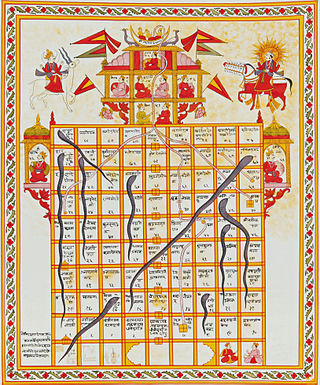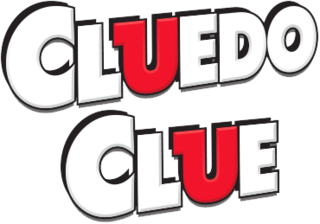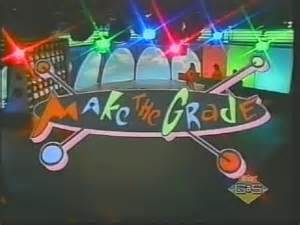
Ludo is a strategy board game for two to four players, in which the players race their four tokens from start to finish according to the rolls of a single die. Like other cross and circle games, Ludo is derived from the Indian game Pachisi. The game and its variations are popular in many countries and under various names.

Monopoly is a multi-player economics-themed board game. In the game, players roll two dice to move around the game board, buying and trading properties and developing them with houses and hotels. Players collect rent from their opponents and aim to drive them into bankruptcy. Money can also be gained or lost through Chance and Community Chest cards and tax squares. Players receive a salary every time they pass "Go" and can end up in jail, from which they cannot move until they have met one of three conditions. House rules, hundreds of different editions, many spin-offs, and related media exist. Monopoly has become a part of international popular culture, having been licensed locally in more than 103 countries and printed in more than 37 languages. As of 2015, it was estimated that the game had sold 275 million copies worldwide. The original game was based on locations in Atlantic City, New Jersey, United States.

Snakes and ladders is a board game for two or more players regarded today as a worldwide classic. The game originated in ancient India as Moksha Patam, and was brought to the UK in the 1890s. It is played on a game board with numbered, gridded squares. A number of "ladders" and "snakes" are pictured on the board, each connecting two specific board squares. The object of the game is to navigate one's game piece, according to die rolls, from the start to the finish, helped by climbing ladders but hindered by falling down snakes.

Cluedo, known as Clue in North America, is a murder mystery game for three to six players that was devised in 1943 by British board game designer Anthony E. Pratt. The game was first manufactured by Waddingtons in the United Kingdom in 1949. Since then, it has been relaunched and updated several times, and it is currently owned and published by the American game and toy company Hasbro.

Scotland Yard is a board game in which a team of players controlling different detectives cooperate to track down a player controlling a criminal as they move around a board representing the streets of London. It was first published in 1983. It is named after Scotland Yard which is the headquarters of London's Metropolitan Police Service in real-life. Scotland Yard is an asymmetric board game, during which the detective players cooperatively solve a variant of the pursuit–evasion problem. The game is published by Ravensburger in most of Europe and Canada and by Milton Bradley in the United States. It received the Spiel des Jahres award in 1983-the same year that it was published.

Civilization is a board game designed by Francis Tresham, published in the United Kingdom in 1980 by Hartland Trefoil and in the United States in 1981 by Avalon Hill. The Civilization brand is now owned by Hasbro. It was out of print for many years, before it saw republication in 2018, by Gibsons Games. The game typically takes eight or more hours to play and is for two to seven players.

Yut nori, also known as yunnori, nyout, and yoot, is a traditional board game played in Korea, especially during Korean New Year. The game is also called cheok-sa or sa-hui. The combining-form -nori means 'game'.
In tabletop games and video games, game mechanics are the rules or ludemes that govern and guide the player's actions, as well as the game's response to them. A rule is an instruction on how to play, a ludeme is an element of play like the L-shaped move of the knight in chess. A game's mechanics thus effectively specify how the game will work for the people who play it.
Monopoly Junior is a simplified version of the board game Monopoly, designed for young children, which was originally released in 1990. It has a rectangular board that is smaller than the standard game and rather than using street names it is based on a city's amusements to make the game more child-friendly. There are many different models of the game.

Barbarossa is a plasticine-shaping German-style board game for 3 to 6 players, designed by Klaus Teuber who based it off The Riddle-Master trilogy by Patricia A. McKillip, it was published in 1988 by Kosmos in German and by Rio Grande Games in English. Barbarossa won the 1988 Spiel des Jahres award.

Make the Grade is a children's game show that aired from October 2, 1989, to September 14, 1990, on Nickelodeon.

Pac-Man Fever is a party game developed by Mass Media and published by Namco, released for GameCube and PlayStation 2 on September 3, 2002, exclusively released in North America. Players move about on a virtual game board, with the object of the game being to reach the end first. It allows for up to four players, featuring six characters from other Namco games to choose from: Pac-Man (Pac-Man), Astaroth (Soulcalibur), Heihachi Mishima (Tekken), Ms. Pac-Man (Pac-Man), Tiger Jackson (Tekken), and Reiko Nagase.

Lord of the Rings is a cooperative board game based on the high fantasy novel The Lord of the Rings by J. R. R. Tolkien. Published in 2000 by Kosmos in Germany, Wizards of the Coast in the U.S., and Parker Brothers in the U.K., the game is designed by Reiner Knizia and features artwork by illustrator John Howe. In the game, each player plays a hobbit in the party, and the party will aim to destroy the One Ring. Upon its release, the game received a Spiel des Jahres special award. A slightly revised version was later published by Fantasy Flight Games.

The board game Monopoly has its origin in the early 20th century. The earliest known version, known as The Landlord's Game, was designed by Elizabeth Magie and first patented in 1904, but existed as early as 1902. Magie, a follower of Henry George, originally intended The Landlord's Game to illustrate the economic consequences of Ricardo's Law of economic rent and the Georgist concepts of economic privilege and land value taxation. A series of board games was developed from 1906 through the 1930s that involved the buying and selling of land and the development of that land. By 1933, a board game had been created much like the modern version of Monopoly sold by Parker Brothers and its related companies through the rest of the 20th century, and into the 21st. Several people, mostly in the midwestern United States and near the East Coast of the United States, contributed to design and evolution.

Tock is a board game, similar to Ludo, Aggravation or Sorry!, in which players race their four tokens around the game board from start to finish—the objective being to be the first to take all of one's tokens "home". Like Sorry!, it is played with playing cards rather than dice.

Titanic: The Board Game is a board game published by Universal Games in 1998 that is based on the sinking of the Titanic. The game was commercially popular, and a reprint was released in 2012. However, critical reviews towards its gameplay and strategy were mixed.

Imaginiff is a party-type board game.

RoboRally is a board game for 2–8 players designed by Richard Garfield and published by Wizards of the Coast (WotC) in 1994. Various expansions and revisions have been published by both WotC and by Avalon Hill.

Machiavelli is a board game published by Battleline Publications in 1977. Set in Renaissance Italy, the board is controlled by the Republic of Florence, the Republic of Venice, the Duchy of Milan, the Kingdom of Naples, the Papacy, Valois France, Habsburg Austria, and the Ottoman Turks.
Hexagony is an abstract strategy board game for 2 to 6 players that was published as Bin'Fa by Taoist Arts Inc. in 1977, as Hexagony by Avalon Hill in 1980, and later re-released in a slightly modified form by Kenterprises as Bin'Fa.


















